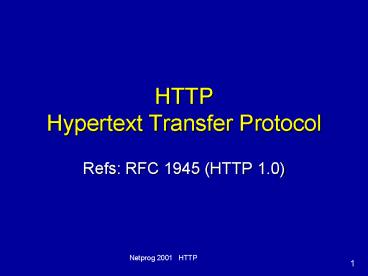HTTP Hypertext Transfer Protocol - PowerPoint PPT Presentation
1 / 33
Title:
HTTP Hypertext Transfer Protocol
Description:
When dealing with a proxy HTTP server, a full URI is used. ... 1220=surgery&0110=doom&0320=bypass. 24. Netprog 2001 HTTP. Typical Method Usage ... – PowerPoint PPT presentation
Number of Views:159
Avg rating:3.0/5.0
Title: HTTP Hypertext Transfer Protocol
1
HTTPHypertext Transfer Protocol
- Refs RFC 1945 (HTTP 1.0)
2
HTTP Usage
- HTTP is the protocol that supports communication
between web browsers and web servers. - A Web Server is a HTTP server
- We will look at HTTP Version 1.0
3
From the RFC
- HTTP is an application-level protocol with the
lightness and speed necessary for distributed,
hypermedia information systems.
4
Transport Independence
- The RFC states that the HTTP protocol generally
takes place over a TCP connection, but the HTTP
protocol itself is not dependent on a specific
transport layer.
5
Request - Response
- HTTP has a simple structure
- client sends a request
- server returns a reply.
- HTTP can support multiple request-reply exchanges
over a single TCP connection, but this is a
special case.
6
Well Known Address
- The well known TCP port for HTTP servers is
port 80. - Other ports can be used as well...
7
HTTP Versions
- The original version now goes by the name HTTP
Version 0.9 - HTTP 0.9 was used for many years.
- Starting with HTTP 1.0 the version number is part
of every request. - HTTP is still changing...
8
HTTP 1.0 Request
- Lines of text (ASCII).
- Lines end with CRLF \r\n
- First line is called Request-Line
9
Request Line
- Method URI HTTP-Version \r\n
- The request line contains 3 tokens (words).
- space characters separate the tokens.
- Newline seems to work by itself (but the protocol
requires CRLF)
10
Request Method
- The Request Method can be
- GET HEAD PUT
- POST DELETE LINK
- UNLINK
- future expansion allowed
11
Methods
- GET retrieve information identified by the URI.
- HEAD retrieve meta-information about the URI.
- POST send information to a URI and retrieve
result.
12
Methods (cont.)
- PUT Store information in location named by URI.
- DELETE remove entity identified by URI.
- LINK, UNLINK create/destroy a link
relationship??
13
Common Usage
- GET, HEAD and POST are supported everywhere.
- HTTP 1.1 servers often support PUT, DELETE,
OPTIONS TRACE.
14
URIUniversal Resource Identifier
- URIs defined in RFC 1630.
- Full URI proto//hostname/path
- http//www.cs.rpi.edu80/blah/foo
- Partial URI /path
- /blah/foo
Identifies the Server
No server mentioned
15
URI Usage
- When dealing with a HTTP server, only a partial
URI is used. - When dealing with a proxy HTTP server, a full URI
is used. - client has to tell the proxy where to get the
document! - more on proxy servers in a bit.
16
HTTP Version Number
- HTTP/1.0 or HTTP/1.1
- HTTP 0.9 did not include a version number in a
request line. - If a server gets a request line with no HTTP
version number it assume 0.9
17
The Header Lines
- After the Request-Line come a number of HTTP
headers. - Each header line contains an attribute name
followed by a followed by the attribute value.
18
Headers
- Request Headers provide information to the server
about the client - what kind of client
- what kind of content will be accepted
- who is making the request
- There can be 0 headers!
19
Example HTTP Headers
- Accept text/html
- From neytmann_at_cybersurg.com
- User-Agent Netscape 4.7
- Referer http//foo.com/blah
20
End of the Headers
- Each header ends with a CRLF
- The end of the header section is marked with a
blank line - \r\n\r\n
- For GET and HEAD requests the end of the headers
is the end of the request!
21
POST
- A POST request includes some data after the
headers (after the blank line). - There is no format for the data (just raw bytes).
- A POST request must include a Content-Length line
in the headers - Content-Length 267
22
Example Request
- GET /hollingd/testanswers.html HTTP/1.0
- Accept /
- User-Agent Internet Explorer
- From cheater_at_cheaters.org
- Referer http//foo.com/
23
Example Post
- POST /CGI-BIN/add_appointments HTTP/1.0
- Accept /
- User-Agent Internet Explorer
- Content-Length 34
- 1220surgery0110doom0320bypass
24
Typical Method Usage
- GET used to retrieve an HTML document.
- HEAD used to find out if a document has changed.
- POST used to submit a form.
25
HTTP Response
- ASCII Status Line
- Headers Section
- Content can be anything (not just text)
- typically is HTML document
26
Response Status Line
- HTTP-Version Status-Code Message
- Status Code is 3 digit number (for computers)
- Message is text (for humans)
27
Status Codes
- 1xx Informational
- 2xx Success
- 3xx Redirection
- 4xx Client Error
- 5xx Server Error
28
Example Status Lines
- HTTP/1.0 200 OK
- HTTP/1.0 301 Moved Permanently
- HTTP/1.0 400 Bad Request
- HTTP/1.0 500 Internal Server Error
29
Response Headers
- Provide the client with information about the
returned entity (document). - what kind of document
- how big the document is
- how the document is encoded
- when the document was last modified
- Response headers end with blank line
30
Response Header Examples
- Date Thu, 27 Jan 2000 124817 EST
- Server Apache/1.17
- Content-Type text/html
- Content-Length 1756
- Content-Encoding gzip
31
Content
- Content can be anything (sequence of raw bytes).
- Content-Length header is required for any
response that includes content. - Content-Type header also required
32
Try it with telnet
- gt telnet www.cs.rpi.edu 80
- GET / HTTP/1.0
- HTTP/1.0 200 OK
- Server Apache
- ...
Request
Blank Line (end of headers)
Response
33
HTTP Proxy Server
HTTP Server
Browser
Proxy































